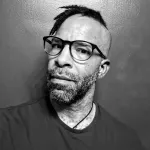The little girl is innocent
they’ve put henna on her hands
they’ve plaited her hair beautifully
they’ve put kohl round her eyes
they’ve dyed her eyebrows
they’ve applied red and white makeup to her doll-like face
like poor girls’ tattered dolls
she now looks ridiculous
The little girl is innocent
she doesn’t see herself
she’s dazzled by her blouse that’s woven with gold thread
the room smells of old rose-water, milk, and sweat
breath suffocates within their chests
the women sing and dance with tambourines and
little drums
the little girl smiles
Women tie white flowers for good fortune,
and second-hand gold jewelry
within her ringlets that are wet with sweat
The little girl thinks
she is a doll
the little girl is innocent
she doesn’t know anything
Her mother looks at her
emptily staring, the hollows of her eyes
filled with pain
in his own world, her father
counts the money
and the old bridegroom
is really happy
The little girl is innocent
she doesn’t know the difference between henna and blood
they’ve prepared her beautifully
for weeping,
she doesn’t know, she doesn’t know…
• Favzieh Rahgozar Barlas captures a snapshot of child marriage, its cultural and economic context, and its physical and emotional aftermath.
- How old do you think the little girl is in the poem? How old is the bridegroom?
- Describe the speaker/persona in the poem. What, if any, are the similarities and differences between them and other characters in the poem?
- There is a lot of repetition in the poem. Three stanzas start with the line, “The Little girl is innocent”. Variations of the line “she doesn’t know” are also found throughout the poem. Does the repetition advance the plot? How?
- The poem is full of sensory language. Some of the images turn into symbols at the end of the poem through repetition and emphasis. Could you spot a few of images-turned-symbols?
- Should you decide to recite this poem, experiment with different ways of saying “the little girl is innocent” and “she doesn’t know”. Are these lines better said the same way each time, with gradual emphasis, or with increasing understatement? Why? Do you think this decision will change the tone of your performance?
Writing Activity
- Write a persona poem in which the little girl is the main speaker. Use the first person (The speaker is “I”). Address and/or describe your father, mother, the bridegroom, the guests, and the speaker of the original poem. Use refrains and repetitions.
- This poem is a translation. If you know another language, choose a poem in that language, and translate it into English.
Useful Links
- Girls increasingly at risk of child marriage in Afghanistan, Statement by UNICEF Executive Director Henrietta Fore: https://www.unicef.org/press-releases/girls-increasingly-risk-child-marriage-afghanistan
- Child marriage is 'a hidden crime,' and it's happening in Western nations, says survivor and advocate, CBC, The Current: https://www.cbc.ca/radio/thecurrent/the-current-for-may-17-2021-1.6029349/child-marriage-is-a-hidden-crime-and-it-s-happening-in-western-nations-says-survivor-and-advocate-1.6029454
Favzieh Rahgozar Barlas' "An Innocent Little Girl" translated by Dick Davis from The Mirror of My Heart: A Thousand Years of Persian Poetry by Women. Copyright © 2019 by Mage Publishers. Used with permission of Mage Publishers. All rights reserved.





